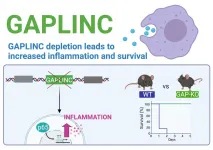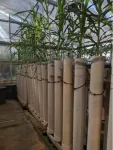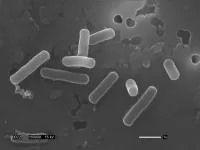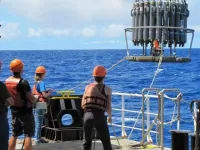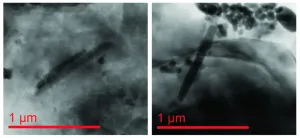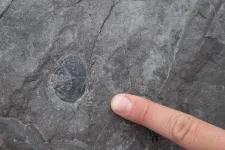February special issue of SLAS Discovery focuses on hit discovery methodologies
The February edition of SLAS Discovery is a special issue on hit discovery methodologies edited by Mark Wigglesworth, Ph.D., (Medicines Discovery Catapult, Stockport, EN, UK) and Peter Hodder, Ph.D. (Amgen, Thousand Oaks, CA, USA)
2021-02-02
(Press-News.org) Oak Brook, IL - The February edition of SLAS Discovery is a Special Issue on Hit Discovery Methodologies edited by Mark Wigglesworth, Ph.D., (Medicines Discovery Catapult, Stockport, EN, UK) and Peter Hodder, Ph.D. (Amgen, Thousand Oaks, CA, USA).
The focus of this Special Issue is to highlight the use of hit discovery methodologies and technologies and their usage in both small molecule and large molecule drug discovery. The February issue exemplifies how technologies, both new and existing, have been applied successfully to find hits.
Additionally, the issue houses a list of the most downloaded articles from SLAS journals, many of which reflect the focus on the implementation, characterization and progression of hit discovery.
The February issue of SLAS Discovery includes nine articles of original research in addition to the cover article.
Articles of Original Research include:
A Homogeneous Cell-Based Membrane Potential Assay to Identify Compounds that Promote Readthrough of Premature Termination Codons in the Cystic Fibrosis Transmembrane Conductance Regulator Ion Channel
High-Throughput Screening and Triage Assays Identify Small Molecules Targeting cMyc in Cancer Cells
Development of a High-Throughput Affinity Mass Spectrometry (AMS) Platform Using Laser Diode Thermal Desorption Ionization Coupled to Mass Spectrometry (LDTD-MS)
Rapid Compound Integrity Assessment for High-Throughput Screening Hit Triaging
High-Throughput Mechanism of Inhibition
AI Driven Iterative Screening for Hit Finding
Toward the Efficient Discovery of Actionable Chemical Matter From DNA-Encoded Libraries
An Automated High-Throughput Fluorescence in Situ Hybridization (FISH) Assay Platform for Use in the Identification and Optimization of siRNA-Based Therapeutics
Comparison of Approaches for Determining Bioactivity Hits from High-Dimensional Profiling Data
Other articles include:
European Lead Factory: Collaborative Innovation in Hit Discovery
High-Throughput Mass Spectrometry for Hit Identification: Current Landscape & Future Perspectives
INFORMATION:
Access to February's SLAS Discovery issue is available at http://journals.sagepub.com/toc/jbxb/26/. For more information about SLAS and its journals, visit http://www.slas.org/journals. Access a "behind the scenes" look at the latest issue with SLAS Discovery Author Insights podcast. Tune in by visiting https://www.buzzsprout.com/1099559.
SLAS (Society for Laboratory Automation and Screening) is an international professional society of academic, industry and government life sciences researchers and the developers and providers of laboratory automation technology. The SLAS mission is to bring together researchers in academia, industry and government to advance life sciences discovery and technology via education, knowledge exchange and global community building.
SLAS Discovery: Advancing the Science of Drug Discovery, 2019 Impact Factor 2.195. Editor-in-Chief Robert M. Campbell, Ph.D., Twentyeight-Seven Therapeutics, Boston, MA (USA).
SLAS Technology: Translating Life Sciences Innovation, 2019 Impact Factor 2.174. Editor-in-Chief Edward Kai-Hua Chow, Ph.D., National University of Singapore (Singapore).
ELSE PRESS RELEASES FROM THIS DATE:
2021-02-02
Las Vegas, Nev. (Monday, Feb. 1, 2021) - In the summer of 2019, Desert Research Institute (DRI) scientist Rosemary Carroll, Ph.D., waited for the arrival of the North American Monsoon, which normally brings a needed dose of summer moisture to the area where she lives in Crested Butte, Colo. - but for the fourth year in a row, the rains never really came.
"2019 had just a horrendous monsoon," Carroll said. "Just the weakest monsoon. And we'd had a few years of weak monsoons before that, which had really gotten me wondering, how important is the monsoon to late summer streamflow here in the Upper Colorado River basin? And how do monsoons influence the following year's streamflow?"
Working in partnership with colleagues ...
2021-02-02
Oak Brook, IL - The February edition of SLAS Technology is a special collection of articles focused on "Artificial Intelligence in Process Automation" by Guest Editor Cenk Ündey, Ph.D. (Amgen, Thousand Oaks, CA, USA).
This SLAS Technology special collection targets the use of artificial intelligence (AI) techniques and technologies as applied specifically to drug discovery, automated gene editing and machine learning. As AI becomes increasingly more prevalent in research, medicine and even everyday life, laboratory automation has gone beyond hardware advancements toward new levels ...
2021-02-01
Risk for a severe form of retinopathy of prematurity, which can cause blindness in extremely premature babies, was halved when the newborns were given a new supplement combining various fatty acids. This was shown in a Swedish study led from the University of Gothenburg.
The study, now published in JAMA Pediatrics, is described as groundbreaking in its field. It documents a clear fall in retinopathy of prematurity (ROP) among extremely premature (EP) infants (born before 28 weeks' gestation), whose retinal blood vessels are not fully developed. The condition can cause ...
2021-02-01
When the body's immune response to an infection gets out of control, the result can be sepsis, a life-threatening condition in which an overwhelming inflammatory response can lead rapidly to failure of multiple organs and death.
In a new study, researchers at UC Santa Cruz have identified a long noncoding RNA (lncRNA) molecule that regulates the expression of pro-inflammatory genes in immune system cells called macrophages and affects the susceptibility of mice to septic shock.
This lncRNA, called GAPLINC, was previously studied for its role in cancer, but it turns out to be the most highly expressed lncRNA in macrophages, which play a central role in inflammation. ...
2021-02-01
A previously unknown root trait allows some cereal plants to grow deeper roots capable of punching through dry, hard, compacted soils, according to Penn State researchers, who suggest that harnessing the inherited characteristic could lead to crops better able to deal with a changing climate.
"This discovery bodes well for American and global agriculture because the trait helps corn, wheat and barley grow deeper roots, which is important for drought tolerance, nitrogen efficiency and carbon sequestration," said Jonathan Lynch, distinguished professor in plant science. "Breeding for this trait should be helpful in developing new crops for climate mitigation."
Called multiseriate cortical sclerenchyma by the researchers -- or MCS -- the phenotype is ...
2021-02-01
New research from North Carolina State University reveals that probiotic Lactobacillus bacteria use enzymes situationally to manipulate bile acids and promote their own survival in the gut. These findings further elucidate the complicated relationship between bile acids and gut bacteria and could eventually enable researchers to design lactobacilli with therapeutic properties, thereby engineering a healthier human gut environment.
Bile acids are key players in digestion and overall gut health. Produced in the liver and released after we eat, these acids not ...
2021-02-01
Just as plants and animals on land are keenly attuned to the hours of sunlight in the day, life in the oceans follows the rhythms of the day, the seasons and even the moon. A University of Washington study finds the biological light switches that make this possible.
Single-celled organisms in the open ocean use a diverse array of genetic tools to detect light, even in tiny amounts, and respond, according to a study published Feb. 1 in the Proceedings of the National Academy of Sciences.
"If you look in the ocean environment, all these different organisms have this day-night cycle. They are very in tune with each other, even as they get moved around. How do they know when it's day? How do they know when it's night?" said lead ...
2021-02-01
There are fossils, found in ancient marine sediments and made up of no more than a few magnetic nanoparticles, that can tell us a whole lot about the climate of the past, especially episodes of abrupt global warming. Now, researchers including doctoral student Courtney Wagner and associate professor Peter Lippert from the University of Utah, have found a way to glean the valuable information in those fossils without having to crush the scarce samples into a fine powder. Their results are published in Proceedings of the National Academy of Sciences.
"It's so fun to be a part of a discovery like this, something that can be used ...
2021-02-01
Most snakes get from A to B by bending their bodies into S-shapes and slithering forward headfirst. A few species, however -- found in the deserts of North America, Africa and the Middle East -- have an odder way of getting around. Known as "sidewinders," these snakes lead with their mid-sections instead of their heads, slinking sideways across loose sand.
Scientists took a microscopic look at the skin of sidewinders to see if it plays a role in their unique method of movement. They discovered that sidewinders' bellies are studded with tiny pits and have few, if any, of the tiny spikes found on the bellies of other snakes.
The Proceedings ...
2021-02-01
CAMBRIDGE -- The temperature of a planet is linked with the diversity of life that it can support. MIT geologists have now reconstructed a timeline of the Earth's temperature during the early Paleozoic era, between 510 and 440 million years ago -- a pivotal period when animals became abundant in a previously microbe-dominated world.
In a study appearing today in the Proceedings of the National Academy of Sciences, the researchers chart dips and peaks in the global temperature during the early Paleozoic. They report that these temperature variations coincide with the planet's ...
LAST 30 PRESS RELEASES:
[Press-News.org] February special issue of SLAS Discovery focuses on hit discovery methodologies
The February edition of SLAS Discovery is a special issue on hit discovery methodologies edited by Mark Wigglesworth, Ph.D., (Medicines Discovery Catapult, Stockport, EN, UK) and Peter Hodder, Ph.D. (Amgen, Thousand Oaks, CA, USA)


